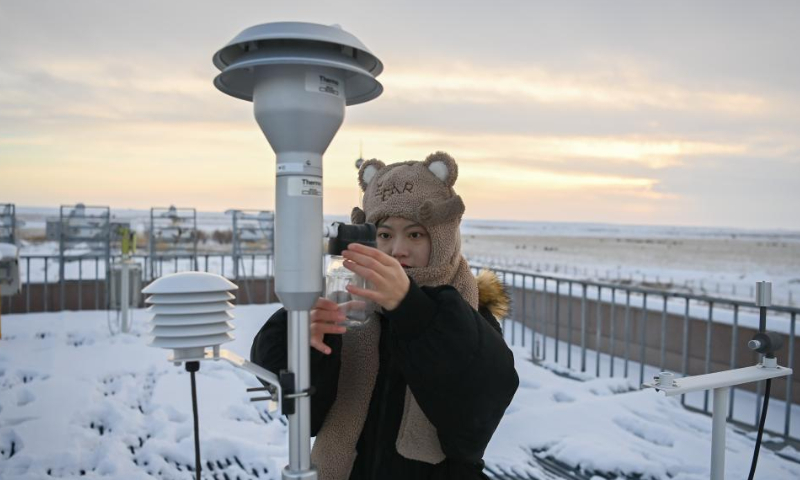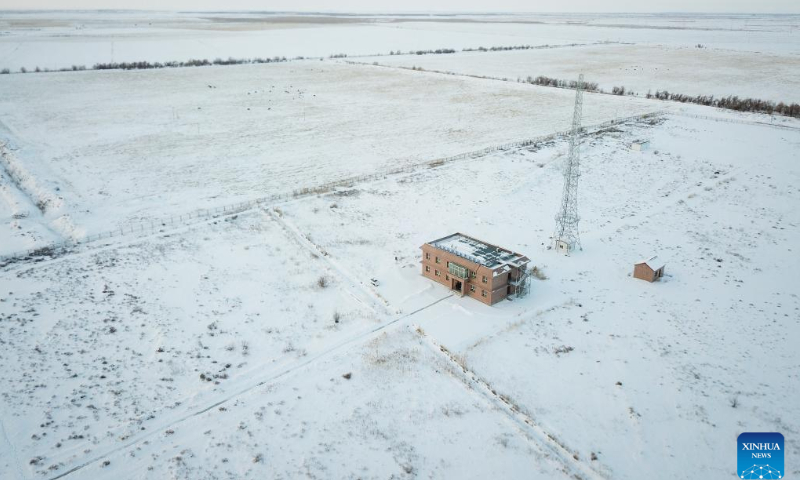
Dong Yinxi, an observer at the Akdala atmospheric background station, checks a monitor equipment at the rooftop in the Junggar Basin, northwest China's Xinjiang Uygur Autonomous Region, Jan. 8, 2023. Photo: Xinhua

This aerial photo taken on Jan. 8, 2023 shows the Akdala atmospheric background station located in the Junggar Basin, northwest China's Xinjiang Uygur Autonomous Region. Photo: Xinhua
When a power outage alarm sounds at about 4 a.m., Dong Yinxi rushes out of her dormitory with a flashlight and trudges through knee-deep snow to her work station over 300 meters away.
Dong is an observer at the Akdala atmospheric background station located in the Junggar Basin, northwest China's Xinjiang Uygur Autonomous Region.
Akdala means "desolate Gobi desert" in Kazak language.
Since 2002, there has been a difference of 85 degrees Celsius between the highest and the lowest temperatures at the station, and the extreme wind speed is 32 meters per second. Consequently, the station often experiences power outages.
Although Dong, 23, has worked there for under a year and a half, she has already developed the habit of running when she hears an alarm.
"The station operates 24 hours a day throughout the year, with four to five people on duty," she said. "The station's emergency power will turn on automatically when there is a power outage, but some equipment may malfunction, so we must rush to the station as quickly as possible, whether we are sleeping or eating."
According to Xinjiang's meteorological service, the Akdala station is located in the upper reaches of China's weather system, far from the interference of human activity and in an area with good air quality.
As one of the seven national atmospheric background stations in China, it currently undertakes more than 40 types of services, including ground observation and greenhouse gas observation, which are important indicators for the evaluation of whether or not the atmosphere is "healthy." Data collection and transmission at the station, therefore, does not stop.
"Figuratively speaking, we are giving the atmosphere physical examinations," said 28-year-old Xie Xiang, another observer at the station, adding that in addition to collecting various kinds of gases, they also collect samples of rain and snow, and maintain the equipment in windy conditions.
"The collected data is not only used in China's annual greenhouse gas bulletin, but it also serves as an early warning for regional atmospheric changes and air pollution," Xie said.
Station head Wang Jianlin, 54, said that to minimize the impact on the local atmosphere, the station's dormitories were built hundreds of meters away from the observation field.
Wang noted that they are cautious about the amount of oil they use while cooking, and their dormitories and other living facilities are heated and powered using clean energy.
During the 14th Five-Year Plan period (2021-2025), the China Meteorological Administration will add more atmospheric background stations across the country to improve greenhouse gas observation capabilities further.
China has announced that it aims to peak its carbon dioxide emissions before 2030 and achieve carbon neutrality before 2060.
"In the new year, I hope the young people at the station will continue to improve their abilities, and that the data collected by the station will make greater contributions," Wang said.
